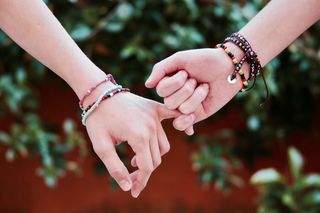Mating
Are Trans People Excluded from the World of Dating?
New research explores the extent to which trans people are excluded from dating.
Posted June 16, 2019 Reviewed by Abigail Fagan
Imagine for a moment that you were to find yourself looking for a new partner at some point in the near future. Perhaps you would turn to a popular dating app and begin filling out your dating profile in hopes of finding "the one." In the process of doing so, you'd likely be asked to indicate your gender and the genders of others that you would be interested in dating. Under these hypothetical circumstances, which of the following people would you consider as a potential dating partner (check all that apply):
- a cisgender1 woman
- a cisgender man
- a transgender woman
- a transgender man
- a person with a non-binary gender identification
Recently, my colleague and I asked this question of just under 1,000 participants and we published our findings in the Journal of Social and Personal Relationships. Our results indicated that 87.5% of the participants who were asked this very question only checked off the cisgender options and excluded transgender and non-binary individuals from their hypothetical dating pool.
It's really not an inconsequential question. For many of my trans friends, the question of whether or not someone will date them after they transition or come out often weighs heavily on their mind. After all, relationships are one of our most important sources of social support. Indeed, our relationships play an important role in our overall mental and physical well-being and our relationships are a better predictor of how long we'll live than smoking or obesity! But, if very few people are willing to date trans people, what does this mean for their health and well-being?

In addition to simply looking at the overall percentages of how many people included or excluded trans persons from their hypothetical dating pool, we also examined the demographics of those who were inclusive. For example, while only a very small minority of cisgender, heterosexual individuals (3.1%) were willing to date a trans person, a much greater percentage of individuals who identified as bisexual or queer provided inclusive responses (55%). One reason for this may be that individuals with queer or bisexual sexual orientations are already looking beyond gender in many ways when selecting a person to date. This also provides some promising insight, as it means that within certain demographic groups, acceptance seems to be much higher.
Looking more closely at the patterns of responses, it also became clear that individuals were least likely to express an interest in dating trans women, even if their sexual identity would otherwise indicate an interest in women. Indeed, nearly 20% fewer people indicated an interest in trans women than would have been expected based on the sexual identities of the individuals within the sample.
The published study did not ask participants for the reasons behind their responses, so future research is needed in order to understand more about what leads to inclusion or exclusion. For example, some may only want to date people whom they can procreate with (although, we don't usually request proof of fertility from prospective partners who are cisgender), others may not fully understand what a trans identity means or entails within a dating relationship, and some may hold negative views towards the transgender community.
One silver lining may be that research has shown that social support from multiple sources can make up for deficiencies in other areas. For example, when individuals in same-sex relationships do not get support from their families, they are often able to turn to their friends to replace that support. Research continuously demonstrates the resilience of LGBTQ communities, and this is no less true for the "T" portion of that acronym. So while this research may show that there is a long way to go in terms of full acceptance of our trans friends and family members within society at large, there is plenty of research that demonstrates how resilient trans and queer people are, even in the face of existing prejudices.
What is the solution? Improving general knowledge and understanding concerning the diversity of gender identities and what each identity means may go a long way in increasing inclusion. Furthermore, increasing accurate media representations of trans and non-binary people, as well as finding ways to increase contact may also be promising, as other research has found that contact with, and additional knowledge about, transgender individuals can effectively reduce trans prejudice.

Ultimately, each individual has the freedom to decide whom they date or are interested in dating, and thus this research does not attempt to make any statements concerning whom an individual should date or consider dating. At the same time, however, understanding the extent to which trans individuals are excluded from the realm of dating can serve as a benchmark for where society currently stands with respect to including trans and non-binary individuals. Just as sociologists have tracked acceptance of inter-racial relationships as a metric of overall societal acceptance of racial minorities, future fluctuations in the extent to which trans and non-binary individuals are included within the intimate world of dating may help to illuminate progress (or lack thereof) with respect to fully including trans and non-binary individuals within our society. After all, it is one thing to make space for diverse gender identities within our workplaces, schools, washrooms and public spaces, but it is another to fully include and accept gender diversity within our families and romantic relationships. Ultimately, however, this research underscores the consequences of shared societal prejudices that impact our trans friends, partners, family members, and coworkers on a daily basis.
1 Note: ‘cisgender’ refers to someone whose current gender identity is the same as the one they were assigned at birth, while ‘transgender’ refers to someone whose gender identity differs from the one they were assigned at birth.)
A version of this blog post first appeared on the University of Cambridge Press' FifteenEightFour Blog in celebration of Pride Month. For the month of June, readers can access a variety of LGBTQ content from Cambridge University Press for free.
Trans Hotline:
US: 877-565-8860
Canada: 877-330-6366
References
Blair, K. L., & Hoskin, R. A. (2019). Transgender exclusion from the world of dating: Patterns of acceptance and rejection of hypothetical trans dating partners as a function of sexual and gender identity. Journal of Social and Personal Relationships, 36(7), 2074-2095.
McDermott, D. T., Brooks, A. S., Rohleder, P., Blair, K., Hoskin, R. A., & McDonagh, L. K. (2018). Ameliorating transnegativity: Assessing the immediate and extended efficacy of a pedagogic prejudice reduction intervention. Psychology & Sexuality, 9(1), 69-85.
Holt‐Lunstad, J., & Smith, T. B. (2012). Social relationships and mortality. Social and Personality Psychology Compass, 6(1), 41-53.
Diamond, L.M. & Blair, K.L. (2019). The Intimate Relationships of Sexual and Gender Minorities, in Anita L. Vangelisti & Daniel Pearlman (Eds.) The Cambridge Handbook of Personal Relationships, pp. 199-210, Cambridge University Press, DOI: https://doi.org/10.1017/9781316417867.017.
This article is free to access for the month of June 2019, as part of the Cambridge University Press Pride Month series.
Dargie, E., Blair, K. L., Pukall, C. F., & Coyle, S. M. (2014). Somewhere under the rainbow: Exploring the identities and experiences of trans persons. The Canadian Journal of Human Sexuality, 23(2), 60-74.




